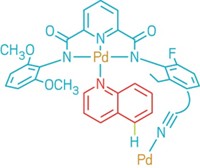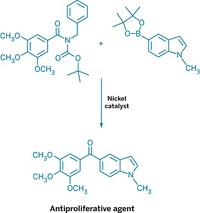Advertisement
Grab your lab coat. Let's get started
Welcome!
Welcome!
Create an account below to get 6 C&EN articles per month, receive newsletters and more - all free.
It seems this is your first time logging in online. Please enter the following information to continue.
As an ACS member you automatically get access to this site. All we need is few more details to create your reading experience.
Not you? Sign in with a different account.
Not you? Sign in with a different account.
ERROR 1
ERROR 1
ERROR 2
ERROR 2
ERROR 2
ERROR 2
ERROR 2
Password and Confirm password must match.
If you have an ACS member number, please enter it here so we can link this account to your membership. (optional)
ERROR 2
ACS values your privacy. By submitting your information, you are gaining access to C&EN and subscribing to our weekly newsletter. We use the information you provide to make your reading experience better, and we will never sell your data to third party members.
Synthesis
Dodging The Substitution Laws
Reaction that yields meta-substituted aromatic rings evades textbook tenets
by Carmen Drahl
March 23, 2009
| A version of this story appeared in
Volume 87, Issue 12

WITH THE HELP OF a copper catalyst, researchers have circumvented the rules of electrophilic aromatic substitution, a fundamental reaction in organic synthesis. The advance enables substitution reactions on an aromatic ring to occur at a traditionally unfavorable position and could lead to more efficient syntheses of materials and pharmaceuticals.

Electrophilic aromatic substitution reactions replace the hydrogen atoms on aromatic rings, such as benzene, with various functional groups, and time-honored rules predict how substituents already on the rings influence what the reaction products will be. Electron-donating substituents such as amines steer the added functional groups to the ortho and para positions, whereas electron-withdrawing substituents such as nitro groups direct to the meta position. Although researchers have developed ways to skirt some of these rules, selectively making meta products in the presence of ortho/para-directing substituents remains a challenge, often requiring extra synthetic steps.
Now, Matthew J. Gaunt and graduate student Robert J. Phipps of the University of Cambridge have proposed a solution that turns the traditional rules upside-down. In the new method aromatic rings featuring ortho/para-directing acyl amines react to give meta-substituted biaryl products (Science 2009, 323, 1593). A copper catalyst seems key to the unusual selectivity—running the same reaction with a palladium catalyst gives ortho-substituted products instead.
"These are completely unexpected results. If this selectivity pattern can be generalized and controlled in other contexts, this chemistry will have substantial utility," says Shannon S. Stahl, an expert on copper catalysis at the University of Wisconsin, Madison.
So far, however, an acyl amine or similar functional group is required for the reaction to work. The carbonyl group is crucial, Gaunt says. Running the same reaction with an amine-substituted benzene ring, identical except for the carbonyl, led to uncontrolled reactivity, he explains. However, the directing group can be transformed into other functional groups after substitution, and the reaction also accommodates handles for further functionalization, he adds.
"While others have devised indirect routes to related structures, the new method is probably the most efficient and will surely lead to more work in an already active area of research," says Mark Lautens, a synthetic chemist at the University of Toronto.
"The study of the structure, synthesis, and reactivity of aromatic compounds has been one of the cornerstones of the teaching of organic chemistry," says Victor Snieckus of Queens University, in Kingston, Ontario, whose work in directed ortho metalation has led to useful routes to polysubstituted aromatics. This finding joins others, including iridium-catalyzed reactions from several groups (Science 2002, 295, 305; J. Am. Chem. Soc. 2002, 124, 390), which may someday supersede the classic rules in relevance in the classroom, he says.
In a complementary advance, a team led by chemist Jin-Quan Yu of Scripps Research Institute has developed a meta-selective reaction that adds olefins to poorly reactive electron-deficient aromatic rings (J. Am. Chem. Soc., DOI: 10.1021/ja900327e). Yu's team designed a ligand that promotes substitution at the meta position, despite the presence of ortho-directing groups.
Currently, Phipps and Gaunt are working to define the mechanism of their meta-selective process, as well as to extend the reaction to more diverse substrates.





Join the conversation
Contact the reporter
Submit a Letter to the Editor for publication
Engage with us on Twitter